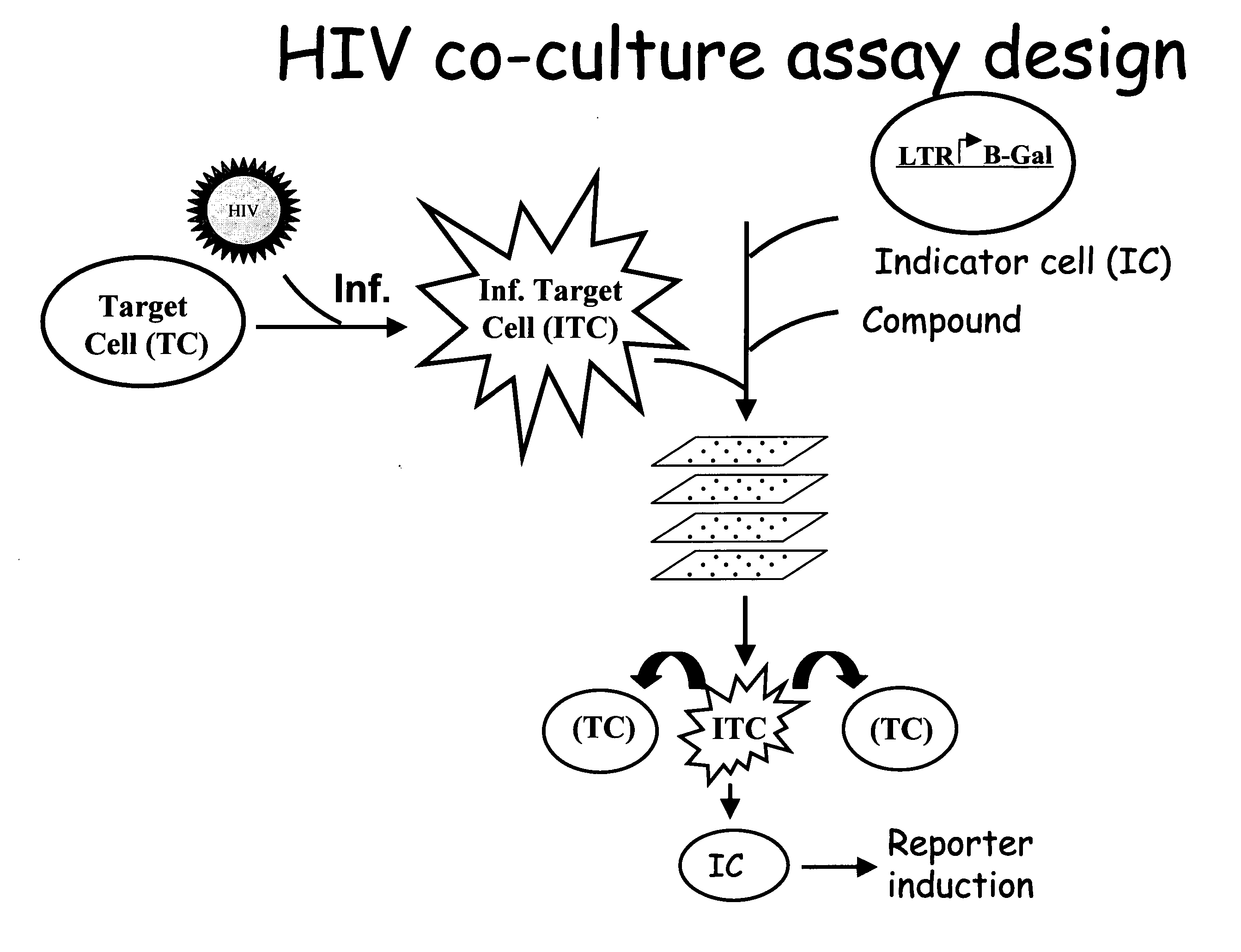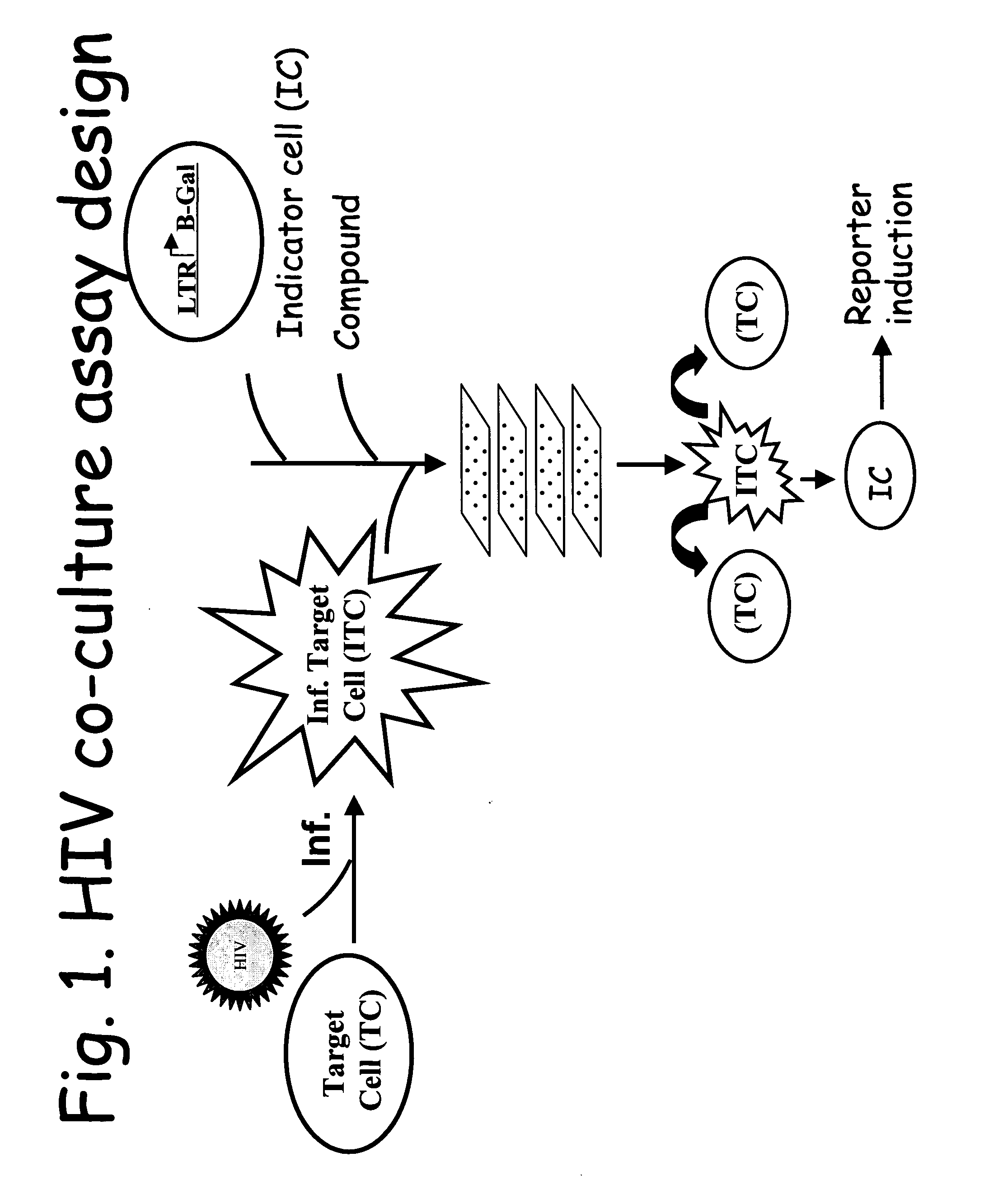Lentivirus assay system including Vif protein activity
a technology of lentivirus and protein activity, which is applied in the field of lentivirus coculture assay system, can solve the problem that the indicator cells do not support high levels of virus amplification
- Summary
- Abstract
- Description
- Claims
- Application Information
AI Technical Summary
Benefits of technology
Problems solved by technology
Method used
Image
Examples
example 1
MT-2 Cell-Based Co-culture Assay Detects HIV-1 Replication and its Inhibition
[0083] MT-2 cells were successfully utilized in the HIV co-culture assay format.
[0084] HeLa CD4 LTR / lacZ indicator cells were added to 96-well microtiter plates at cell densities of 1×104 cells / well in DMEM or RPMI medium (Life Technologies) containing 10% FBS (HyClone). MT-2 cells were infected with HIV-1 NL4.3 using 656, 1312, 2624, or 5248 TCID50s per 1.6×104 cells. Two hours after infection, infected MT-2 cells were washed with RPMI medium (Life Technologies) and added to the 96-well microtiter plates containing the HeLa CD4 LTR / lacZ indicator cells. The final MT2-cell densities in the indicator wells were 1.6×104 cells / well. Certain of the wells with indicator cells also included either non-nucleoside reverse transcriptase inhibitor EFV or protease inhibitor NFV at final concentrations of 0.1 uM or 1 uM, respectively.
[0085] Virus replication was measured 4 days after infection by quantifying HIV-1 T...
example 2
PM1 Cell-Based Co-Culture Assay Detects HIV-1 Replication and its Inhibition
[0090] PM1 cells were successfully utilized in the HIV co-culture assay format.
[0091] These experiments were conducted by a modification of the method employed in Example 1. The modifications were as follows: PM1 cells were used in place of the MT-2 cells. PM1 cells were infected with HIV-1 NL4.3 using 656, 1312, 2624, or 5248 TCID50s per 2×104 cells.
[0092] The results showed a significant induction of β-Gal activity in the co-culture assay format, which was dependent on viral input (TCID50). At the highest virus TCID50 (5248), a 265-fold induction of reporter gene signal was observed in the co-culture assay, with a maximum signal of ˜97,000 relative light units (FIG. 3). In addition, >99% of the reporter signal was inhibited by ≧10×EC90 concentrations of the non-nucleoside reverse transcriptase inhibitor EFV or the protease inhibitor NFV in the co-culture assay (FIG. 3).
[0093] These results demonstrate ...
example 3
Direct Infection HeLa CD4 LTR / lacZ Indicator Cells by HIV-1
[0094] This Example compared the present HIV co-culture assay with a known reporter cell-based assay method. This known method involved direct infection of HeLa CD4 LTR / lacZ indicator cells with HIV-1 (Kimpton and Emerman, J. Virol., 66(4):2232-2239 (1992)).
[0095] HeLa CD4 LTR / lacZ indicator cells were directly infected with TCID50s identical to those used in the co-culture experiments described in Examples 1 and 2. HeLa CD4 LTR / lacZ indicator cells were infected directly with HIV-1 NL4.3 using 656, 1312, 2624, or 5248 TCID50s per 1×104 cells.
[0096] As with the co-culture assay, a significant induction of β-Gal activity was observed after directly infecting the HeLa CD4 LTR / lacZ indicator cells, which was dependent on viral TCID50. At the highest virus TCID50 (5248), a 247-fold induction of β-Gal activity was observed, with a maximum reporter gene signal of ˜63,000 RLUs measured (FIG. 4).
[0097] In these direct infection ...
PUM
 Login to View More
Login to View More Abstract
Description
Claims
Application Information
 Login to View More
Login to View More - R&D
- Intellectual Property
- Life Sciences
- Materials
- Tech Scout
- Unparalleled Data Quality
- Higher Quality Content
- 60% Fewer Hallucinations
Browse by: Latest US Patents, China's latest patents, Technical Efficacy Thesaurus, Application Domain, Technology Topic, Popular Technical Reports.
© 2025 PatSnap. All rights reserved.Legal|Privacy policy|Modern Slavery Act Transparency Statement|Sitemap|About US| Contact US: help@patsnap.com



